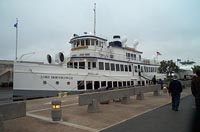![]()
![]()
![]()
![]()
![]()
|
|
|
![]()
ROOTS Summit 2002 : The EndoConvergence of Digital and Educational Technologies
Presenters : Dr. Arnaldo Castellucci, Dr. John Stropko, Dr. L Stephen Buchanan, Dr. Bill Watson, Dr. Eric Rindler, Dr. Jim Simon, Dr. Ilan Rotstein, Dr. E. Herbranson, Dr. Glen Van As, Dr. Joe Dovgan , Dr. Jerry Avillion, Dr. Harvey Wiener , Dr. Rick Schwartz, Dr. Gary Glasmann, Dr. Liviu Steier , Dr. Joe Maggio , Dr. Paul Bery , Dr. Yosef Nahmias, Dr. Stace Lind, Dr. Fred Barnett , Dr. John McSpadden, Dr. John West, Dr. Clifford Ruddle & Dr. Carlos Boveda
by Rob Kaufmann DMD MS
|
|
||||||
|
I'm on my way to Summit 2 in San Diego. Could it get any better than Summit I? How would the atmosphere change with about 230 people registered instead of 65? Would the weather be as sweltering as in Toronto? Would half the audience leave to enjoy the California sunshine? Could we pull it off without Kendo? Who would win those amazing ($$) Raffle Prizes? Would Fred Barnett come out of the closet and finally reveal his "Dark Side"? These and many more questions were on my mind as I checked into the San Diego Wyndham Emerald Plaza on Tuesday June 4 for Roots 2. Looking back at the entire program, I can't help but be impressed by the breadth of talent and topics that are presented. And the SUPPORT from the commercial side was unprecedented. I just can't imagine how the people like Steve J. and Bob G. managed to convince the bean counters to invest in a meeting like ROOTS. They must have known that their big investment would pay off in much higher profile for their products and I believe the success of the Summit will bear them out in the bottom line. Suffice to say that ROOTS Summits have now served as a prototype for face to face meetings of internet based SIGSs (Special Interest Groups). It CAN be done with quality. It simply blew away the Chicago AAE and was by far the best didactic learning experience I have had since Grad school. Don't believe me? Just ask Cliff Ruddle. Here's a quote from him as he started his lecture "I think the ROOTS meeting will now become my AAE." High praise from one of the best. By keeping the lectures short, ROOTS forced the presenters to be concise and to concentrate on the "stuff that matters". No time for extraneous BS. It worked. There was lots of "editing" of the lectures on the fly, but that only served to "tighten up" the presentation, make it more interesting and leave you "wanting more". The result only served to whet our appetites for ROOTS III. (As one of the presenters mentioned : Good presentations are like a woman's skirt : Long enough to cover the subject matter but short enough to keep you interested. J) How did they do it? They did it with some amazing Powerpoint presentations that incorporated both radiographic, still and video images. Congratulations to Fred, Joe and Peter for keeping the meeting moving and doing a perfect job of scheduling. The days flew by ! Arriving in the evening of Tuesday June 4th, I see that the Global gang is hard at work assembling the 25 microscopes that will be used for tomorrow's all day microscope workshop. I marvel at the shipping crates piled high in the corner of the room. (Glenn later tells us that half of the microscope shipment actually did not arrive on time and was "misplaced" at the airport, adding to the initial panic. It was located and assembled in time. Whew !)
|
||||||
|
|
||||||
|
|
||||||
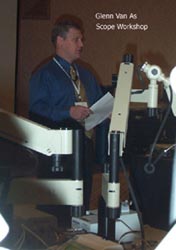 |
Wednesday a.m. - General Dentist Scope Workshop Glenn Van As does a great job of discussing why he believes scopes are essential to good practice. Never mind the fantastic visibility, it saves your back when you use it properly. How much is THAT worth to you over your entire career? Advice on chair and operator positioning. Lots of good photos from his CD-R ( I bought it after last year's Summit &endash; the video should be out soon.) BTW, as many of your know ROOTS finally has convinced ME (the scope luddite) to jump the shark. Yes, the ceiling mount was installed while I was in San Diego. I'm awaiting delivery any day. (Note to Gary Carr: I am a pygmy no more !) Wednesday p.m. - Endodontist Scope Workshop Every station is to be equipped with the latest gear: Global microscope, Bien-Air Electric handpiece (man, those are soooo smooth, I'm gonna have to get one !) Ultrasonic units (one of 2 types !), Rotary engines (ATRs or DTCs with sets of sponge mounted Ni-Ti files of several different designs.) Extension cords are everywhere. For the p.m. Endo workshop, there are packages containing tapered diamonds, hand files, access burs, mouth mirrors, DG 16s, a mounted dentoform and even molars pre-mounted in plaster! For those that want to obturate, there are System Bs, Gutta percha and sealer. We have everything we need. And all for a frighteningly small $75 per session (a.m. or p.m.) The logistics of getting the stuff there and setting it up must have been a nightmare. I wonder how they've done it. I retire to my room to rest up. I've got to pace myself if I'm going to last until Sunday. |
|||||
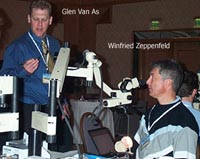 |
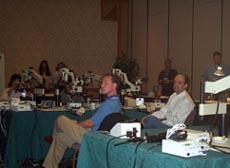 |
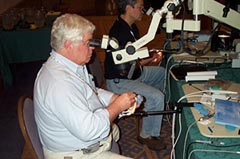 |
||||
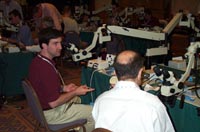 |
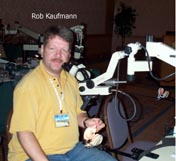 |
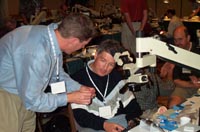 |
||||
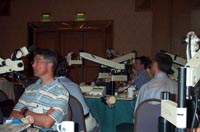 bbbbbbbbbbbbbbbbbbbbbbbbb bbbbbbbbbbbbbbbbbbbbbbbbb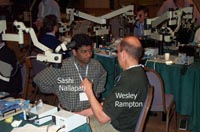 |
||||||
|
||||||
|
|
||||||
|
|
||||||
|
|
||||||
|
Dr. John Stropko - MTA in Endodontic Practice |
||||||
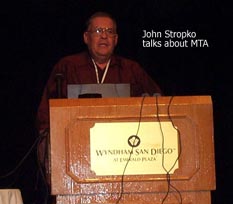 |
John's the perfect guy to start. Great sense of humor, and what a clinician ! Stropko loosens us up with some seriously funny (isn't that an oxymoron?) video. I can't begin to describe those 30 second segues but lets just say that they broke everyone up and set the tone for a day of amazing fun Endo education. It turns out that John's previous pre-dental experience with the cement industry has made him the perfect guy to give us tips on using MTA. (Such as why it needs moisture, why you need to "vibrate it" in retrofills etc.) He tells us that the new white MTA is old MTA with the Fe removed. John shows us some great examples of treatment and reminds us NOT to "pack" the stuff into the prepared area. He's not a fan of the new Dentsply carriers but highly endorses the Dovgan carrier. (It appears that Joe " I'm not making anything on those" Dovgan has another great product. That's ANOTHER thing I've GOT to buy!) I like John's lecture style. While John is obviously a exceptional clinician ( Hey…he's a Boston U guy after all!), he comes across as "just one of the guys", very humble. (Presentations are just so much better when presenters check their egos at the door.) It adds to the cozy atmosphere of the meeting and helps bring all of us closer as a group. Cool! Great lecture. I look forward to his Microsurgical Update tomorrow, at the same early time. |
|||||
|
|
||||||
|
Drs. Nahmias and Bery - The Capture Zone Dudes |
||||||
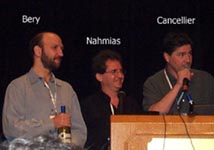 |
The Capture Zone Dudes present an interesting investigation of the effects of different preparation techniques on the shapes of "Capture Zones". Ie/ Some use Protapers, Profiles, LightSpeed, GGs combinations, hybridization etc. They reported on an informal survey of ROOTS clinicians that they performed. Clinicians' shaping methods and techniques were studied with reference to the apical shapes that their methods produced. Neat idea because it relates directly to a lot of the cases we see posted on ROOTS. We now get a better idea of WHY finished cases are shaped the way they are and how that affects the look of the fills. It ended with a quiz that featured the finished radiographic cases of the various clinicians that were kind enough to volunteer (!?) their cases for scrutiny. We were asked to "match" the case with the shape of the capture zone produced by different clinicians. Very entertaining and informative. Just the kind of lecture that appealed to the operator in all of us, while at the same time allowing us to "see" what other ROOTers were doing. Nice job, guys. |
|||||
|
|
||||||
|
Dr. Eric Herbranson - Digital Photography and the DOM |
||||||
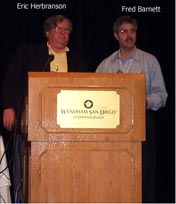 |
This could NOT have been better timed presentation if I had custom ordered it. Since I am getting my scope in only a few days AND have purchased (but not used) a Nikon 950, this was the perfect lecture for me. Eric goes through digital imaging fundamentals, shows us the X Mount ( I bought that with my scope too!) and then does a great tutorial/comparison of the old and new megapixel digital cameras for the scope. Its like having your own prosumer camera consultant answering all those nagging questions that you forgot to ask before you bought your camera. Wow ! Not only that, he goes through the important settings on the 9** series Nikons AND gives us some help with optimizing our digital images in Photoshop. (After struggling with Photoshop v 5.5 I imagine that's at least whole day lecture by itself. I only wish I had more time to hang out with this guy and learn about imaging. He certainly seems to know his stuff.) Make sure to check out the Xmount.com for other great info that Eric is providing. Also a great lecture style… simple explanations, even complex ideas were explained so all could understand. Great images ! BRING ERIC BACK next year ! I want more. |
|||||
|
|
||||||
|
Dr. Harvey Weiner- Single Visit Endo - Is it really better? |
||||||
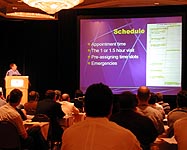 |
I honestly didn't know how Harvey would handle this issue, considering the considerable controversy it has generated on ROOTS. Having been at the full day seminar at the AAE in Chicago, I observed first hand the controversy between the CaOH based multi-appointment camp (as represented by Trope and the Europeans) and the single appointment philosophy (as represented by Steve Cohen). On the basis of the presentations that day and on the literature support, you'd have to give that round to Trope et al, but I'm still not convinced because I believe that a lot of the Viking literature is not representative of good clinical technique as we on ROOTS define it. Ie/ Patency, position of fill etc. Perhaps it was a good thing that Harvey didn't get into those kind of specifics this time around. Instead of immersing himself in the fight between the one step vs. two step clinicians, Harvey chose to go the less didactic route and focus on how his own practice had changed over the years and how he chose to incorporate new ideas and technology into his Endodontics. This included single appointment treatment, digital radiography and scope use as well as his association with Nova, the new Florida dental |
|||||
|
school. It was more of a "things change and we all must change with the times" type of retrospective and I am sure it gave food for thought to many of us who have not yet taken advantage of these new technologies in our own lives. ( What? ROOTers WITHOUT technology? Who are these guys ? ) Did he sidestep the issue a bit? Yeah, I suppose so but I'm not sure what I would have done in his place, knowing that 15 feet away, in the front row, Freddie Barnett &endash; the walking referencemeister &endash; would be ready to pounce on every "works for ME!". Maybe it's best to leave sleeping dogs lie. Besides, we need to save something for ROOTS 3. |
||||||
|
|
||||||
|
LUNCH !!! At this point most other conferences would break for lunch, let the attendees come up for air and then resume after that. NOT SO WITH ROOTS! ? Even though we need to refuel, we keep the learning coming ! Just when I think that they have thought of everything…there's more. I remember: Lunches for Thursday, Friday and Saturday are also provided as part of the registration fee. UNREAL ! For $300 ! How can they afford to do this ? Amazing. I wonder again: How did ROOTS manage to pull this off? Peter and Joey remind us that it is time to buy the raffle tickets and support the new Server. I buy 2 @ $50 each. Naw….better make that 4. It's for a good cause and for some peculiar reason, I'm feeling lucky. Am I right? We'll find out when they begin drawing later. |
||||||
|
|
||||||
|
Dr.Cliff Ruddle - Lunch with Learning - Microsonics in Endodontics |
||||||
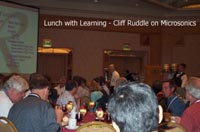 |
You gotta love a guy who pulls no punches and has the conviction and talent to pull it off. With acknowledgments to his initial explorations with Gary Carr, Cliff takes us through an excellent review of "Microendodontic Ultrasonics" &endash; Microsonics as he calls it. The first slide comes up and we immediately know that he can't begin to cover all the topics. But Cliff shows us why he's one of the top clinicians in the world. Great cases, discussion of instrument removal, the Post removal System. Man, that's a lot to digest…not including lunch. |
|||||
|
|
||||||
|
Dr. Arnaldo Castelluci - Retreatment Using the SOM |
||||||
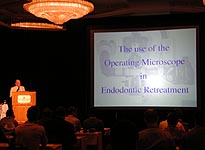 |
I must admit that I had not seen Arnaldo lecture before and was completely blown away by the quality and innovation of his scope use and material. The highlight of his presentation was a case in which he managed to pack a canal conventionally through the side of the root using a surgical approach! Whoa ! We can only wonder what the referral thought when he took a look at THAT final post op report. Is this guy innovative or what? Since his practice is almost entirely retreatment. Arnaldo showed tons of retreatment cases and some real beauties. It kind of makes me glad that I don't have to tackle those kind of cases day in and day out, as a rule.There's another ROOTer that merits an encore at the next meeting. Bravo Dr. Castelluci ! I look forward to your next appearance. |
|||||
|
|
||||||
|
Dr. Jerry Avillion - The System A |
||||||
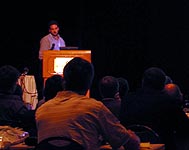 |
I didn't envy Jerry's job. The murmuring from Dr. Castellucci's presentation was still in the air when Dr. Avillion took the stage. One thing we know about Jerry, he's definitely not shy in voicing his opinions on ROOTS. Many of us have enjoyed the banter on ROOTS between Jerry and Joey D. in the area of "standards of care". I had heard a lot about the PacMac technique but never fully understood how the instrument and technique were used. Jerry took us through the steps of this thermal (friction generated) obturation technique. As a classic warm GP trained clinician, I was at first skeptical about the ability to control the material ( especially in patent or larger foramina) but Jerry showed some outstanding cases (complete with nice fill anatomy) so you must give the guy his "props". I'm not sure I'll ever use it but the results seem to speak for themselves. He patiently answered questions about this method and I believe entire audience came away with greater understanding and appreciation for "another way" of getting the results that we want. |
|||||
|
|
||||||
|
Dr. Rick Schwartz - The Endo Perio Continuum |
||||||
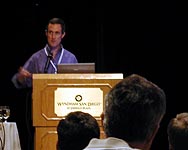 |
One of the biggest problems that we face as endodontists in the challenge of the periodontally challenged tooth that appears to be endodontically involved. The Periodontist prays for endodontic involvement so that he has a decent chance of having the endodontist fill that POE and help him to repair the attachment apparatus. In other cases the situation may require a combined or coordinated approach. Rick gave us an overview of the diagnosis and discussed different treatment scenarios. He emphasized working closely with his Periodontist colleagues and asking for their assistance when the procedures involved areas where their expertise was greater. (Proper treatment coordination and/or referral at the right time is the hallmark of a quality clinician!) It was an excellent presentation of some of the more difficult situations that we face when treating a compromised tooth. The quality of Dr. Schwartz's endodontics (and the glowing introduction from Freddie B.) again showed why we are so fortunate to have talent like this available on ROOTS. |
|||||
|
|
||||||
|
The program ends at 5 pm and I am not ashamed to say that I am exhausted. What a day ! So many facts ! So much expertise! Can I absorb it all ? Can I remember any of it and take it all home? Then I remember one more thing: I've got two more days to go !! Peter Cancellier reminds us that we have to be ready at 6 pm to go for the dinner/cruise. I'm a mess. A quick shave, shower, call to the family and we're off again! |
||||||
|
Dinner Cruise on the Lord Hornblower |
||||||
|
||||||
|
|
||||||
|
|
||||||
|
Dr. John Stropko - Microsurgical update |
||||||
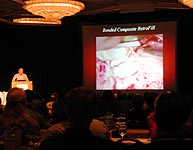 |
When you have the kind of surgical expertise that John has, its easy to show how its done. ( I was especially impressed with the great surgical results &endash; no scarring at all.) Stropdude ran through the entire surgical spectrum. Some of his suggestions: -When surgerizing roots with an isthmus, make small "dots" along the isthmus with an ultrasonic tip. This allows you to create a 'tracking groove" that prevents your ultrasonic tip from wandering off the isthmus. Then its just a matter of "connect the dots" with your ultrasonic tip. Neat trick. - Crypt Control is crucial during surgery . He uses Monsel's solution, Epidry and CaSO4. - Plan your sutures at the time you make the incision. |
|||||
|
- He uses the Dovgan CaSO4 carrier. John also likes Joey's idea of using the opposite end (the stick end) of a cotton applicator to gently pack the CaSO4 into the crypt. - He is not intimidated by working in the sinus and when necessary packs it with 1 long strand of _ inch plain sterile gauze ( one continuous piece tied with a safety suture.) - John sees great potential for the new BMP (Bone Morphogenic Protein) as an aid to healing and in guided bone regeneration. - His protocol for composite retrodseal &endash; 1. rinse prep with alcohol 2. Etch with Ultradent Blue Gel 3. Place Optibond with Carr explorer, allowing it to flow into the prep 4. Cure with light. All I can tell you is that once I've had a little more experience with my scope, I'm giving some serious though to joining him and Joe Dovgan for one of their courses in Arizona. |
||||||
|
|
||||||
|
Dr. John McSpadden - New Developments in Rotary instrumentation |
||||||
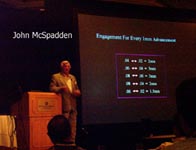 |
Dr. McSpadden's lecture was basically a repeat of his AAE presentation in Chicago. (Unfortunately, the 3D component had to be omitted at the last moment due to the costs involved in setting it up.) Dr. McSpadden is one of the world's foremost authorities on instrument design, metallurgy, testing and reasons for fracture. He showed us pictures the machines he designed for testing rotary instruments. (Big bucks there !) He focused mostly on the scenario we all dread &endash; Ni-Ti rotary instrument breakage. His philosophy was summed up as "Excellence while accommodating for risks and time" ( What a practical solution!!) John believes that understanding the reasons for failure will make it less likely that we will break them. He discussed the two factors (Fatigue and Torque) that cause failure. He stated that he believed Crown Down Technique (without first creating room for instruments ) means that you are working with the tip and this can lead to breakage. |
|||||
|
McSpadden also told us that with his experience in testing these instruments, he can determine the degree of curvature position and size of the canal. John does this by "feeling" the canal with the pressure required to create the shape with the rotary file itself. I trained on hand files and used them for many years because I believed that Rotary instrumentation lacked this "feel". If he can do this, it is a remarkable achievement that we need to strive for. It is obvious that he truly loves this type of investigation and ROOTS is fortunate that he interacts with us on a regular basis. His posting on ROOTS some time ago (where he tested and described his findings) should be a classic paper and needs to be read by those contemplating use of this technique. Truly a giant in the Endo Tech world. Thanks for joining us John, your contribution was greatly appreciated and enjoyed by all. |
||||||
|
|
||||||
|
Dr. Cliff Ruddle - The Protaper System |
||||||
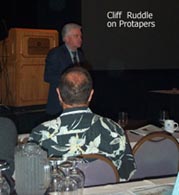 |
Cliff came out with guns blazing. Spurred on by Dr. McSpadden's presentation, Ruddle opened with my favorite topic: The Issue of the Literature vs. Practicality of Treatment. He said that although Endodontics has progressed, we still are faced with the problems of 1. Confusion 2. Technology and 3. Misinformation (I believe Dr. Schein's post about this and Cliff's phone call to him have cleared this up #3.) The confusion lies in that we currently have no true agreement such subjects as frequency of irrigation, size of access, conservation of tooth structure, heating of irrigation, the effects of radial lands file design on tubule blockage, apex vs. coronal first treatment, or ideal taper. In one of the rare "exchanges" during the seminar, Ruddle took issue with some of John McSpadden's remarks about the Protaper. It was one of the few times where we saw strong disagreement between presenters. While respectful of Dr. McSpadden's contributions to rotary instrumentation, it was obvious that he was disappointed about Dr. McSpadden's findings regarding the ProTaper instruments Cliff helped design. He felt that the lab tests were not truly representative of their use in the clinical setting. He believes that constant taper instruments with lands are not representative of the most efficient modern files and that the different tapers in the ProTaper series represent a newer Third generation of instruments. |
|||||
|
With so many different instruments, designs, hybridization of techniques, it was refreshing to hear him go through the ProTaper technique in a clear concise manner. Cliff believes in the concept of the "scouting file" to explore the canal space as you work. Here is a brief synopsis of his technique as I understood it: (1) Establish straight line access to the canals by determining that the Scouter files "stand up straight" in the access. This will determine whether the case is considered "On-Axis" or "Off-Axis". There should be no "preconceived exact mm length" for the canal prior to this point ie/ a length to which you MUST get your instruments. Scouter files are used short of the apex initially. Do the Scouter file work on the "outstroke" only. ( I can't help but notice that many of Cliff's concepts are straight out of the BU technique.) (2) Protaper S1 placed to Scouter file length (short). Look for debris at the top of the file ( not the tip!). (3) Protaper SX used in a brush stroke if "Off Axis. NO PECKING ! (4) Now go to estimated length with a #15 file/ EAL. ( This is important because the initial straightening of the canal may have reduced the working length by as much as 1 mm. (If take a working length before you remove the coronal dentin, your rotaries may end up working 1 mm long in molars. This can result in tearing of the apex.) With this method you are more likely to maintain true working length. (5) Protaper S1 to same length . THIS may be MINIMALLY "Long"! Check patency with #10 file. Irrigate. (6) Protaper S2 . This cuts in the MIDDLE 1/3rd of the root. (7) Maintain patency and NOW confirm working length with EAL and film. This is the final working length you want. (8) Protaper F1 . This blends the apical 1/3rd with the middle third. When it is _ to 1mm short, remove it. If it does not go to length, recapitulate and irrigate again. (9) In Big, thick canals and when shape dictates &endash; use F2 and F3 short of the apex. ( rare) He explained the reasons for the various tapers along the instrument, the value of having fewer instruments to use and also addressed the possible reasons for fracture when the instruments were not used in the correct sequence. In a nutshell, he believes that if you can place a STRAIGHT (not precurved) N-Ti hand file to the apex, then you are ready to use rotary instruments to that length…not before. I hope I described his technique correctly. Cliff, let me know if I made an error. It is obvious why he is so successful at getting his message across. Cliff is a skilled lecturer and dynamic speaker. He is passionate about Endodontics. Again, we are fortunate to have him think so highly of ROOTS and I look forward to his future involvement with us. |
||||||
|
|
||||||
|
Dr. Joe Maggio - The K3 Rotary System |
||||||
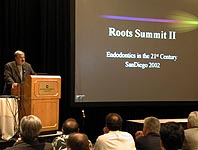 |
Dr. Maggio had a tough act to follow. His presentation about the K3 was less controversial and stuck to the "K3 script". As such it really came across as more of a "brochure read" and didn't offer a lot of insight as to why we should be using this instrument instead another type. Joe addressed the "cross section" controversy that was generated at the AAE. ( During that meeting, one lecturer presented what was proprted to be a K3 instrument &endash; in cross section- that looked nothing like the supposed K3 shape). Dr. Maggio assured us that this was not the case. He described the K3 technique as recommended by Kerr Sybron. There wasn't much that didn't fit the manufacturer's standard script. Overall, an average presentation. I would have preferred a little more comparison with other instruments and discussion of why we should use it over other designs. Many of our ROOTs members have just begun using this file successfully and it still may be too new for us to have comparison data and studeis. A updated presentation at ROOTS 3 would be a good idea. |
|||||
|
|
||||||
|
Lunch and Learn - Joe Dovgan - Diagnostic Dilemmas |
||||||
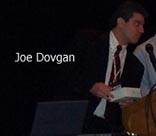 |
What a pleasant surprise ! We all knew that Joey D. knew had the right stuff. He proved it last year with his ROOTS presentation on Office Asepsis. Although this year's talk seemed to address the more basic concepts of diagnosis (most of the Endodontists in the room know this stuff as second nature and I got the impression it was geared more toward the Generalist) I was most impressed with the graphics and presentation. So much so that I'd like to get a copy of the PPT file if I could . I especially like the referred pain skull illustrations. ( Joey D. , PLEASE ?? I promise all graphics will get credit.) Just great meat and potatoes diagnosis from a guy who knows how to present a no-nonsense tutorial. We also have to understand that this was being done while he, Peter and Fred were handling all the other myriad of duties associated with running ROOTS 2. Thanks, Joey D. |
|||||
|
|
||||||
|
Dr. John West - Creating the Endodontic Practice of Your Dreams |
||||||
|
ROOTS Summit II did not limit itself to the purely clinical. John West's presentation dealt with the important topic of practice satisfaction. What is it that makes us come to work each day? What makes our work fulfilling for us as a person? How can we make our overall environment conducive to producing more energy and positive motivation? John showed us pictures of his new $3M dollar clinic and explained his philosophy of practice. Wow. That's some edifice and some committment. He explained the "Stages" of practice and how we often are afraid to make the changes that will let us create the practice of our dreams. ( Raise your fees- for one.) I'm not sure that all of his concepts are applicable to my situation here in Canada or other countries. (The idea of patients "paying more" for quality healthcare is profoundly influenced by having a socialized medical system. That's something J.W. doesn't have to confront in the US.) However, my initial skepticism was won over by his obvious dedication, enthusiasm, conviction and true belief in himself. He is obviously interested in maintaining the highest of standards both clinically (another BU guy!) and philosophically when it comes to what we all do for a living. |
||||||
|
|
||||||
|
Dr. Jim Simon - Success and Failure |
||||||
|
Dr. Simon's lecture took me completely by surprise. I was expecting another "let me show you why this failed" lecture. Instead, he had some shocking news for me: Not all lesions heal, even when you do the endo perfectly. (This is not what I was led to believe in Grad school.) Dr. Simon discussed such interesting concepts as "apical plaque", "pseudomonas and actinomycetes in apical infections and their relation to failure of apparently good endodontic cases". He concluded with a discussion of possible viral involvement in periapical lesions ( a topic that I had presented as a possible master's thesis in 1984 but that was rejected because "viruses weren't a factor in periapical disease".) Talk about "rock your world" ! Although I now feel a little less guilty when one of those perfectly packed cases fails to heal, it does make me wonder about what we can do with these cases in the future. Dr. Simon believes that in order to get healing some cases just have to be surgerized to remove the infected tissue. That was both comforting and alarming at the same time. Just when I thought I had a handle on success and failure. |
||||||
|
|
||||||
|
Friday Night featured our own Dr. Peter Cancellier pounding the skins with his band at the Redfish Restaurant. Unfortunately, I was unable to attend due to a other commitments. From the rawness of Peter's hands the next morning it looked like it was quite a party. I was sorry I missed it. |
||||||
|
|
||||||
|
|
||||||
|
Dr. Carlos Boveda - The Endo Restorative Continuum |
||||||
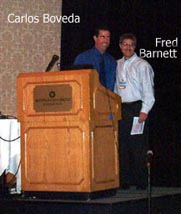 |
Have you seen Carlos' website? www.carlosboveda.com Its done with a Mac and it shows. His presentation was similarly spectacular. Complete with references and beautiful cases. Rather than bore you with text descriptions that could never ever do him justice, I suggest that you log on to his website. It will give you an idea of the kind of stuff we saw. Very, very nice. We need to bring him back next year. I know of one rooter who taped the whole lecture and gave a copy to him. I'm going to see if I can get a copy from Carlos, just to review it again. Considering that English is not his first language, Carlos and other presenters like Dr. Stier are to be commended for their courage. It must have been very tough to stand on the podium, considering the level of knowledge and expectations of the audience. An outstanding job. BTW, Carlos says he is always looking for interesting cases to post on his site. Check it out soon. |
|||||
|
|
||||||
|
Dr. S. Lind - The AET System |
||||||
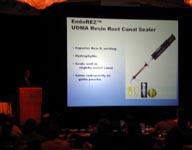 |
Dr. Lind gave us some insight into Ultradent's AET instrumentation and resin sealer systems. The premise behind the instrumentation system is that canals are not round and that pure rotary instrumentation does not address this problem adequately. With the reciprocating handpiece design and motion of the files, he claims that canals are more thoroughly cleaned. Unfortunately, I missed the sealer portion due to a bathroom break. Maybe someone else can provide the details. |
|||||
|
|
||||||
|
Dr. Steve Buchanan - The Pro-GT System |
||||||
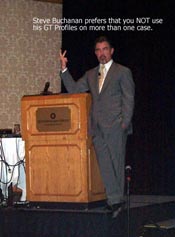 |
The man who popularized Ni-Ti rotary and brought it to the masses was with us. He explained how the instruments were developed, his preferred method of treatment and the need for prolonged "soaking times". (That is another interesting concept. I'm not sure that clinicians (who can clean and shape canals in a few minutes) will have the patience to let their patients sit in the chair for 40 minutes to let the NaOCl work. There is a LOT of pressure to produce in the average practice and the temptation to pack these "shaped" canals without adequate contact time with NaOCl is very high.) Dr. Buchanan raised a few eyebrows with a couple of comments. With regards to instrument breakage through repeated use, he said that if you are going to use GTs more than once, he preferred that you NOT use his instruments. He felt that the speed and ease of treatment more than made up for the additional cost. (Although that may be true in the US, there are ROOTS members &endash; especially those dealing with fixed fee socialized national dentistry- that may find that concept hard to swallow.) I know some ROOTers in the front row had a real tough time with the concept that any particular case could be cleaned and shaped with "only one instrument". I congratulate ROOTS for bringing Steve B to the meeting. It's just one more example of how quality attracts quality. People are starting to understand about ROOTS and are attracted by our need to learn, explore and understand. The fact that we could get Steve B. for free is a measure of how the Endodontic community is catching on to Kendo's concept of the Nexus. |
|||||
|
|
||||||
|
Lunch and Learn - Dr. Fred Barnett - Endodontic Treatment of Traumatic Injuries |
||||||
 |
Hey! This guy can teach. Fred gives everyone a great "lecture" (and not just when he's on ROOTS vbg)…he's not just a walking footnote. Naturally, CaOH is his solution for a LOT of the problems associated with trauma. (He's a Viking!) Fred gave us an overview of types of injuries, the treatment and prognosis for each. (He did admit that Andreasen nearly caused a riot recently when he suggested that treatment of some roots treated with CaOH may cause weakened dentin and for that disclosure I must commend him. It must have been VERY hard for Vikings to hear that. J Don't worry Fred; I'm sure your Scandinavian friends will somehow find a way to disprove that!) I was very impressed with his overall knowledge, lecture style and comfort level…even when faced with the noisy lunch crowd. He even took one potshot at ME. Dr. Barnett also provided a copy of a recent published article on this topic. I'm sure he can send it to you by E-mail if you didn't get a copy or are interested. Deserved to be there, for sure. We also owe him a debt of gratitude for helping things run smoothly. He's now patent, he's now puffing. …Watch out, his conversion to the Dark Side is almost complete. (And NO, the anticipated knock down, drag em out fight between us that many people were anticipating did not occur. We shared opinions, learned something about each other and gained respect for each other's point of view. That's what ROOTS is all about.) |
|||||
|
|
||||||
|
Dr. Ken Reed - Total Pain Control |
||||||
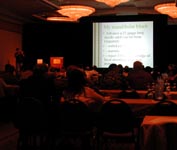 |
Dr. Reed gets the ROOTS II Speedmeister award for most words per minute! Man, does he talk fast! (I think he even left some of us native English speaking guys wondering what he said. I can only imagine what some of our foreign guests must have thought. ) Although 80 % of the patient's he works on are asleep (lucky him!!!) he did give us a great overview of pain control and the medications used to deal with it. Fortunately, he gave us printed handouts of his material and has also posted on the Kerr-Sybron Summit 2 website. If you are interested in his techniques for anesthesia (such as The Greater Palatine approach that anesthetizes the WHOLE side of the maxilla), check out the site. Here are some highlights: |
|||||
|
- Uses larger gauge (mostly long) needles (25,27) because of higher rate of breakage associated of 30 gauge short needles. - Does not like the "bent needle " technique or "hubbing " short needles because of risk of breakage. (Both techniques that I have been using successfully for more than 20 years! Oh well.) - Described techniques for mandibular blocks. - Believes problems with paresthesia are more associated with 4% solutions. - Discussed X tip/Stabident that he recommends you use WITHOUT vasoconstrictor. With this technique Marcaine gives you 40 mins. anesthesia, Carbocaine 20 mins. Most importantly, he described the Ceiling Analgesic Dose (CAD). This is the "best" that you can do with the medication you prescribe. You want to get as close to this as possible. Exceeding this is not necessary and often not effective. They are: ASA 1000 mg Acetaminophen 1000 mg Codeine 60 mg Hydrocodone 10 mg Oxycodone 10 mg He likes: Vicodin = Acetominophen 500 mg Hydrocodone 5 mg. 2 tabs of this med matches the CAD exactly. Lortab = Acetominophen 500 mg Hydrocodone 5 mg. 2 tabs of this med matches the CAD exactly. (One formulation of Lortab has ASA 500 mg instead of Acetominophen) Percocet &endash; RARELY required. Use this version Acetominophen 500 mg Oxycocone 7.5 mg (ie/ has extra oxycocone in patients with extreme discomfort) Tylox - Acetominophen 500 mg Oxycodone 5 mg (He describes as a "good choice") NSAIDS- Naproxen, Anaprox, Aleve &endash; Good for soft tissue problems MOTRIN (Ibuprofen) &endash; Basically the drug of routine choice. 400-600mg for pain, 800 mg has good anti-inflammatory properties. For acute pain you can give up to 3200 mg/day, for chronic use maximum daily dose is 2400 mg. ORUDIS &endash; another of his favorites but hard to find. Ceiling Analgesic dose 50 mg. He suggests you write script for 75 mg. Capsule 1 tab q6-8 hrs. Max daily dose 300 mg. TORADOL- 10 mg tabs Toradol 10 mg = 6mg IM morphine for dental pain. Injected version &endash; 15 mg = 12 mg IM morphine. It comes in 60 ml vial (liquid- 4 doses) and can be injected IM or injected orally). He suggests following up with 40 mg oral tabs. (I've used this medication with variable results) |
||||||
|
|
||||||
|
Dr. Liviu Steier - The Endo Restorative Continuum |
||||||
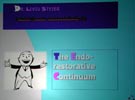 |
I can only imagine how difficult it must have been for Dr. Steier to walk up to the podium and do his presentation in English. He did a marvelous job of explaining proper postoperative endodontic restorative procedures. Most importantly (for me) he showed that the newer posterior composite restorations could work when they are placed properly ! Congratulations on some beautiful illustrations and some great work. |
|||||
|
|
||||||
|
Dr. Ilan Rothstein - Intracoronal Bleaching |
||||||
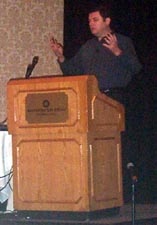 |
Dr. Rothstein showed us that he had a sense of humor and understood that everyone was just plain worn out by this time. (Hence the "last speaker" joke he started with.) He had a good chuckle when the audience suggested that the best tool for consistent bleaching of discolored teeth was.... Photoshop 6.0!! (Ha!) No photo funny business here, all cases were done legitimately. There were certainly some dramatic results shown. Dr. Rothstein suggested that use of heat and Superoxol in non-vital bleaching cases was the source of many problems, such as post op external resorption and that these should not be used in treatment. He suggested that equally good results could be obtained merely by the use of sodium perborate (without the Superoxol) although I got the impression that the treatment may take a few more appointments over a longer time. Dr. Rothstein also emphasized the need for proper base placement over the gutta percha filling in order to protect the tooth from factors that could cause external resorption. (I personally have encountered this problem with many of my generalist referrals and it places the endodontist in the very uncomfortable position of trying to explain to patients why apparently successful endodontic treatment has deteriorated to the point where the tooth often has to be extracted. NOT a good situation for the referral, the patient or me!) |
|||||
|
|
||||||
|
I looked around at around 5 pm and there were still lots of people glued to their seats. Tired, but still there. The final draws were made during the last two days and we were pleased to see a Dental student win the big prize that included a complete GT system &endash; rotary engine, files and obturation system, graciously provided by Tulsa Dental. Vista Dental also contributed an irrigation system (I believe the list price was over $2000!). I was fortunate enough to win two prizes! (My hunch about buying 4 tickets was correct.) I am now the proud owner of some new Gary Carr mirrors (just in time for my scope installation!!) and a set of 5 Spartan Ultrasonic Retroprep tips. Awwright! Lucky me! I saw lots of activity at the vendor booths and I hope that ROOTS members bought lots. (Or plan to buy when they get home.) Your support of these vendors and their products is crucial to their assisting us in the future. I would also personally ask you to encourage your fellow Endodontists and referrals to log on and attend the next Summit. If each of us convince just one or two people to join us (I managed to convince a couple of dentists in the Compuserve Dental forum &endash; Drs. Mark Portnoy and Allan Huber) we can double or triple attendance. Once the lecture was over, we adjourned to an adjacent room where a few of ROOTers had brought some of their favorite spirits from their home countries for us to sample. I was bushed but still managed to have a glass of a very strong Brazilian concoction that I don't remember the name of. (That says something about the drink itself!) There was more talk, some more shared opinions and a lot of questions about how and who could possibly make things even better next year. SD 2002 would be tough to beat. Because of family commitments (my 8 year old daughter's dance recital) I had to leave at 6 a.m. on Sunday so I missed the Sunday presentations and the Gattling Gun session. Perhaps another ROOTer could provide us with a synopsis. Thanks for reading and as always, comments (online or via rmk@endoexperience.com) are welcome. If you missed a portion of the story, you can read it again when I post it on my website www.endoexperience.com in a couple of weeks. See You in Salt Lake City, UT in 2003 at ROOTS 3 |
||||||
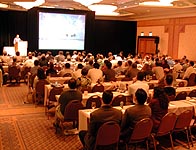 |
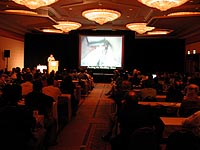 |
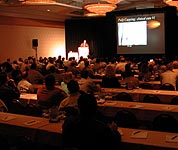 |
||||
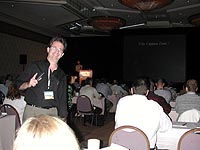 |
 |
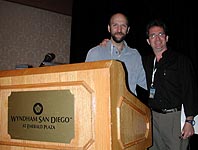 |
||||
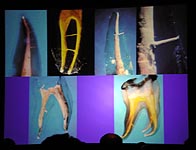 |
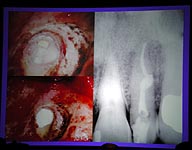 |
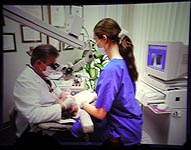 |
||||
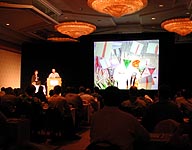 |
 |
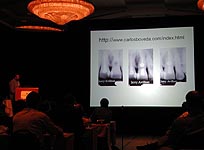 |
||||
Comentarios? carlosboveda@carlosboveda.com
![]()




